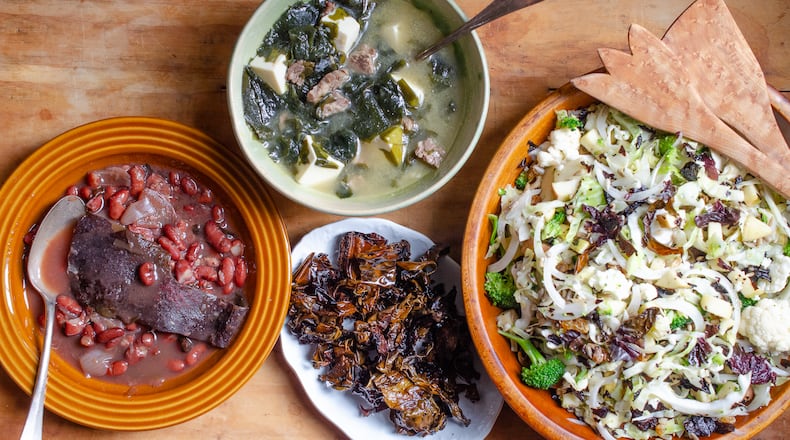Seaweed is a popular ingredient in Asian cuisines, but many of us only know it as the wrap for sushi rolls or the perforated sheets of keto-friendly snacks. Umami-rich, highly nutritious and with a low carbon footprint, seaweed is an excellent ingredient to add to your pantry.
Seaweed can be a confusing term. According to the Monterey Bay Aquarium’s Seafood Watch, there are over 10,000 types of seaweed. (I’m a Seafood Watch Blue Ribbon Task Force member, a group of chefs and culinary leaders who promote sustainable seafood.) In addition, the same seaweed can go by different names, depending on the language spoken.
There are three main groups of seaweed: Brown algae include kombu, also known as kelp, wakame and hijiki. Red algae include nori and dulse. (Yes, nori is a red alga, not green. The green color is a result of its being dried and toasted.) Green algae include sea lettuce and sea grapes.
Seaweed is a valuable source of plant-based protein, low in calories and nutrient-dense. It is packed with essential vitamins, minerals and nutrients, including iodine, which supports thyroid health, and fiber, which aids digestion.
The vast majority of seaweed is farmed and emerging as a sustainable choice as concerns about climate change and food security grow. Seaweed absorbs carbon dioxide, and farming it does not require land, fresh water, pesticides or fertilizers.
Seaweed is available dried and sold in packets of different sizes and most often labeled in the language of the country of origin with an English translation on the back of the package. You can find seaweed at international markets, Asian markets and health food stores. Depending on the seaweed, it may need rehydrating before use.
Seaweed is versatile and can be used as a main ingredient in a recipe or as a seasoning, similar to adding a bay leaf to a pot of soup. It has become integral in many vegan and vegetarian recipes for its meaty flavor. For more traditional ways to cook seaweed, look to Asia, where it has been consumed for centuries.
The Korean Miyeok Soup with Beef and Tofu is a home-style nourishing soup served to new mothers. Made solely with water as its base, it is vibrant and bursts with flavor from the seaweed. The leaves become tender, almost spinach-like, but are still slightly toothsome.
You can also lean into seaweed’s robust flavor as a “vegetarian ham bone,” as with Kombu Beans. Including dried kelp when cooking beans is a technique made popular by the Washington Post food and dining editor Joe Yonan in his book “Cool Beans” (Ten Speed Press, 2020). The leathery kombu becomes soft and pliable, nearly melting into the beans.
And you can make your own seaweed snacks. Dulse is a seaweed that, when fried, becomes crispy, similar to a kale chip. It can be eaten on its own or used as a plant-based bacon substitute as in the Winter Slaw with Dulse Bacon Bits.
RECIPES
Seaweed can be part of new dishes in your repertoire or a replacement ingredient for current ones. Incorporating this intensely flavored and versatile zero-input crop can be delicious, good for your health and good for the health of our food systems.
Credit: Virginia Willis
Credit: Virginia Willis
Kombu Beans
Kombu, also known as kelp, is used in the Japanese stock called dashi, the base for miso soup. It makes a wonderful addition to a pot of beans or soup. It becomes very soft and tender once cooked and can be eaten along with the beans.
If using the pressure cooker or Crock-Pot, there is no need to soak the beans. If using the stovetop method, soaking the beans is not mandatory but can slightly speed up the cooking process. To soak beans before cooking, place them in a bowl and cover with cold water. Let soak overnight. Drain and proceed with the recipe. To quick-soak the beans, place them in a pot and cover with water by 1 inch. Bring them to a boil, turn off the heat, cover the pot with the lid and let the beans soak for an hour. Drain and proceed with the recipe.
- 1 pound dried red beans, rinsed and picked over
- 6 cups water
- 1 onion, coarsely chopped
- 4 cloves garlic, smashed
- 1 5-inch piece dried kombu
- 1 teaspoon coarse kosher salt
- ¼ teaspoon freshly ground black pepper
Pressure cooker method: Combine beans, water, onion, garlic and kombu in a pressure cooker. (Do not season with salt until the end of cooking.) Cook on the bean setting or high, 30 minutes. Allow the steam to naturally release. Season with salt and pepper.
Slow cooker method: Combine beans, water, onion, garlic and kombu in a slow cooker. Set the cook time for 6 hours on low or 3 hours on high. Cook, tasting the beans occasionally to check for tenderness. When the beans are just tender, season with salt and pepper and continue to cook until the desired texture is achieved. Total cook time will vary according to the age of the beans.
Stovetop method: Combine beans, water, onions, garlic and kombu in a heavy-duty pot. Bring to a boil over medium heat. Reduce heat to simmer and cook, occasionally stirring and tasting the beans for tenderness. Once the beans are just tender, season with salt and pepper and continue simmering until the desired texture is achieved. Total cook time will be 1 1/2 to 2 hours, depending on the age of the beans.
Serves 6.
Per serving (1 cup): 267 calories (percent of calories from fat, 3), 17 grams protein, 49 grams carbohydrates, 2 grams total sugars, 12 grams fiber, 1 gram total fat (trace saturated fat), no cholesterol, 213 milligrams sodium.
Credit: Virginia Willis
Credit: Virginia Willis
Winter Slaw with Dulse Bacon Bits
This recipe is based on the potluck favorite Broccoli Slaw, but we mix it up with a variety of brassicas and substitute crumbled dulse bacon bits for traditional bacon.
- 1 apple, diced
- ¼ cup apple cider vinegar
- 1 tablespoon Dijon mustard
- ¼ cup pure olive oil
- ¼ teaspoon freshly ground black pepper
- ½ green cabbage, thinly sliced (4 cups)
- ½ cauliflower, cut into florets (2 cups)
- 1 broccoli crown, cut into florets (2 cups)
- ½ sweet onion, thinly sliced
- ½ recipe Dulse Bacon, crumbled (see recipe)
- Combine the apple, apple cider vinegar and mustard in a small bowl. Add the oil and stir to combine. Season with pepper.
- Combine the cabbage, cauliflower, broccoli and onion in a large mixing bowl. Pour the apple cider dressing over the vegetables. Stir to combine and coat. Add the crumbled dulse bacon and stir to combine. Serve immediately.
Serves 6.
Per serving: 172 calories (percent of calories from fat, 61), 2 grams protein, 15 grams carbohydrates, 8 grams total sugars, 5 grams fiber, 12 grams total fat (2 grams saturated), no cholesterol, 101 milligrams sodium.
Dulse Bacon
Dulse is a variety of red seaweed that can grow up to 20-inches long. Once dried, it can resemble a wad of crumpled paper. It is astonishingly salty when eaten straight out of the bag, but mellows and smooths once cooked. When fried, it offers a flavor akin to bacon. When the dulse is cooked it will lose its reddish-brown color and turn deep green.
- 1 ounce dulse
- ¼ cup pure olive oil
- Use your fingers to flatten the dulse and smooth the wrinkles. (It doesn’t need to be completely flat, but you want it in a sheet, not crumpled together.) Line a plate with paper towels.
- Heat the oil in a large skillet over medium-high heat. Add the prepared dulse and cook, stirring with a spatula or wooden spoon often, until the dulse is crispy, 2 to 3 minutes. Remove to the prepared plate. Serve warm or room temperature. Store in an airtight container at room temperature for up to 2 days.
Serves 4.
Per serving: 92 calories (percent of calories from fat, 80), no protein, 5 grams carbohydrates, 0 grams total sugars, 2 grams fiber, 8 grams total fat (1 gram saturated), no cholesterol, 118 milligrams sodium.
Credit: Virginia Willis
Credit: Virginia Willis
Korean Miyeok Soup with Beef and Tofu
The seaweed in this soup is known as wakame in Japan and miyeok in Korea. It makes a vitamin-rich broth that is traditionally served to new mothers to aid in post-birth recovery. As a result, it’s also known as “birthday soup” and is enjoyed throughout life by both women and men on their birthdays to honor their mothers.
- 1 (22 gram) package miyeok, also known as wakame
- 1 tablespoon toasted sesame oil
- ¾ pound skirt steak, cut against the grain into ½-inch pieces
- 4 garlic cloves, very finely chopped
- 8 cups water
- 2 tablespoons fish sauce
- 1 (16 ounce) carton soft tofu, cubed
- Soak the miyeok in a bowl of room temperature water until rehydrated, about 20 minutes.
- While the miyeok soaks, heat the oil in a large pot over medium-high heat. Add the beef and cook until lightly browned and no longer pink, about 3 minutes. Add the garlic and cook until fragrant, 45 to 60 seconds. Add water and fish sauce.
- Increase the heat to high and bring to a boil. Reduce heat to simmer and cover. Cook, stirring occasionally, until the beef is very tender, about 40 minutes. Add tofu and cook until heated through, about 5 minutes. Serve immediately.
Serves 6.
Per serving: 208 calories (percent of calories from fat, 55), 20 grams protein, 4 grams carbohydrates, 1 gram total sugars, 2 grams fiber, 13 grams total fat (4 grams saturated), 37 milligrams cholesterol, 798 milligrams sodium.
Sign up for the AJC Food and Dining Newsletter
Read more stories like this by liking Atlanta Restaurant Scene on Facebook, following @ATLDiningNews on X and @ajcdining on Instagram.
About the Author
Keep Reading
The Latest
Featured






